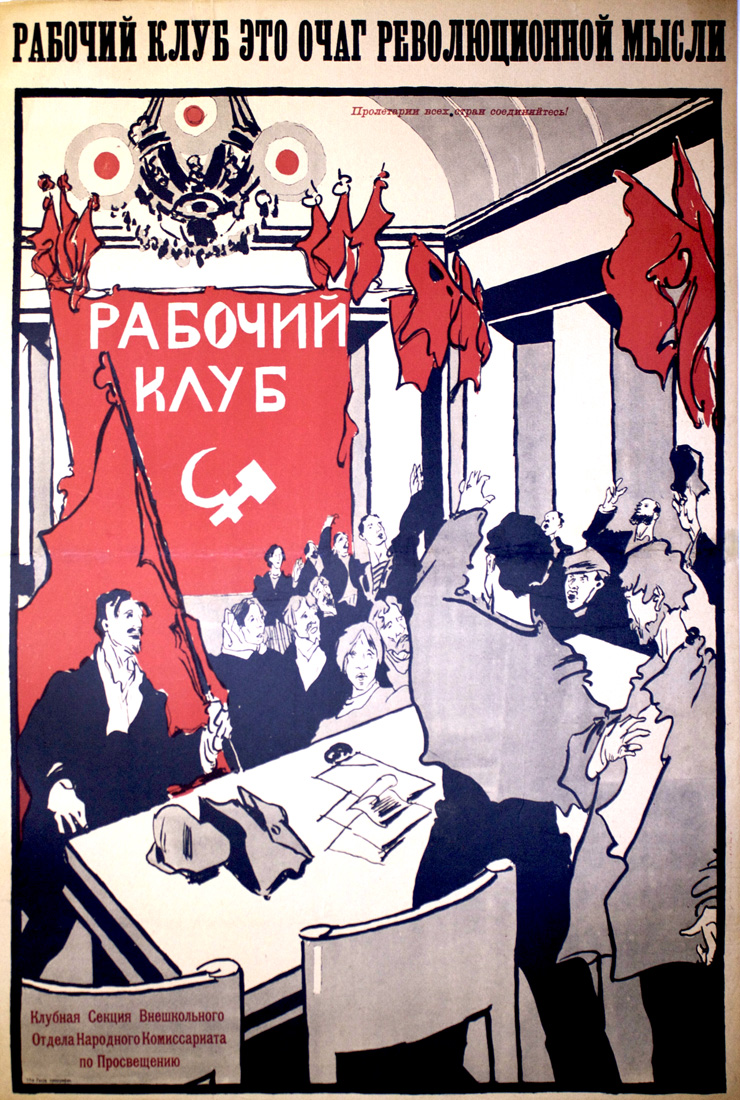
La Asociación de Trabajadores es el corazón del pensamiento revolucionario. [Parte inferior izquierda] Sección de la Asociación del Departamento de Extramuros del Comisariado de Educación Pública.
Número de Cartel: PP 468
Información sobre el cartel: [On banner] Workers’ Club; [At top right] Workers of the World, Unite!; In the 1920s, the government developed clubs for trade unions, political organizations and workers. These were often housed anywhere there was extra space such as in former residences and churches. The clubs were non-restrictive and served as cultural outlets. According to architectural historian Anatole Kopp, a club was provided as a place that was, "...no longer that of an elite but of the mass, no longer acquired in the silence of the study or in halls of learning, but in a group bound by common interests and an awareness of their need."
Tamaño: 39x30
Tipo de cartel: Litografía
Fecha de publicación: c.1919
Información técnica: Published by the Club Section of the Extracurricular Department.
Fuentes: Soviet Posters of the era of the Civil War 1918-1921 by B. S. Butnik-Siverskii (1960), page 497 poster 3366
En el catologo: PP 468 Communist Culture b
Artista: Artist Unknown — неизвестный художник
The artist's name on the poster is not indicated. By assigning Artist Unknown to a poster it also could mean the artist used a chop mark whereby no signature is seen thus rendering the artist's identity anonymous.
Leer más...
Imprenta: 15th State Typography Workshop, Petrograd [St. Petersburg] — 15-я Государственная типографская, Петроград
The 15th State Typography Workshop began its history as the lithographic partnership of Roman Golike and Artur Vil’borg from 1902 to 1918. It was located at 11 Zvenigorodskaia Street in Petrograd (St. Petersburg). After being nationalized shortly after the October Revolution, it became the 15th State Typogaphy. In 1922, the printer was placed in the State-controlled printing trust of Petropechat' and it was renamed in honor of Ivan Fedorov (c.1525-1583) who is often referred to as the fi...
Leer más...
Editorial: Narkompros (People’s Commissariat for Education) — Наркомпрос
The People's Commissariat for Education (Narkompros) was formed in 1918 and it encompassed the former Imperial Ministry of Public Education, the State Education Committee, and the former Palace Ministry (an entity that managed theaters, the Academy of Arts and the royal palaces). Overseeing Narkompros was the All-Russian Central Executive Committee (VTsIK). As the main educational branch of the government, Narkompros carried out a compliment of programs such as the combating of illiteracy, professional education, adult education, ...
Leer más...